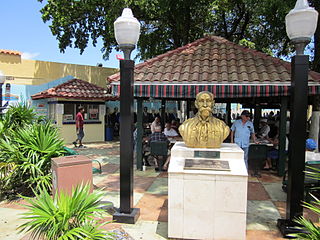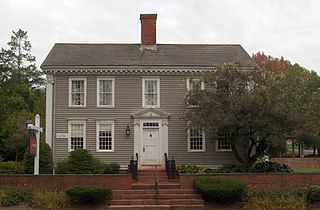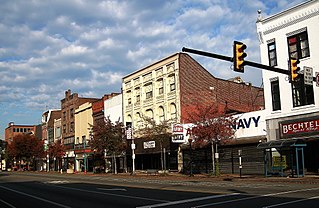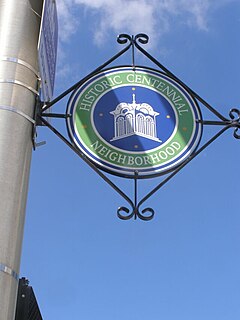
Little Havana is a neighborhood of Miami, Florida, United States. Home to many Cuban exiles, as well as many immigrants from Central and South America, Little Havana is named after Havana, the capital and largest city in Cuba.

Guilderland Center is a hamlet in the town of Guilderland, Albany County, New York. The hamlet lies along New York Route 146 and the Black Creek, a tributary of the Normans Kill.

The High Hills of Santee, sometimes known as the High Hills of the Santee, is a long, narrow hilly region in the western part of Sumter County, South Carolina. It has been called "one of the state's most famous areas". The High Hills of Santee region lies north of the Santee River and east of the Wateree River, one of the two rivers that join to form the Santee. It extends north almost to the Kershaw county line and northeasterly to include the former summer resort town of Bradford Springs. Since 1902 the town has been included in Lee County.

The Our Lady of the Rosary Roman Catholic Church is located at 5930 Woodward Avenue in Detroit, Michigan. It was originally built as St. Joseph's Episcopal Church - from 1893 to 1896 - and is a historic Romanesque Revival church complex. It was added to the National Register of Historic Places on August 3, 1982.

The Simsbury Center Historic District is a 75-acre (30 ha) historic district located in the town center area of Simsbury, Connecticut. It encompasses seven blocks of Hopmeadow Street, as well as the cluster of commercial, civic, and residential buildings along Railroad, Station, and Wilcox Streets, and Phelps Lane. Although its oldest element is the cemetery, most of its buildings were built in the late 19th and early 20th century. It was listed on the National Register of Historic Places in 1996.

The Kinderhook Village District is located in the central areas of the village of Kinderhook, New York, United States. It is a 612-acre (248 ha) area covering both developed and undeveloped land centered on US 9.

The St. Mary's Church Complex Historic District is a historic district located at the junction of Elm Avenue and North Monroe Street (M-125) in the city of Monroe, Michigan. It was listed as a Michigan Historic Site and added to the National Register of Historic Places on May 6, 1982.
Spier, Rohns & Gehrke was a noted Detroit, Michigan architectural firm operated by Frederick H. Spier and William C. Rohns, best remembered for designs of churches and railroad stations. These were frequently executed in the Richardson Romanesque style. F.H. Spier, W.C. Rohns and Hans Gehrke were authors of the Detroit Chamber of Commerce, tallest building in the city at the time of construction (1895). Hans Gehrke's well known structures include the Fire Department Headquarters on Larned Street in Detroit, and residence of Robert C. Traub in Arden Park residential district of Detroit.

The Old Mauch Chunk Historic District is a national historic district located at Jim Thorpe, Carbon County, Pennsylvania. The district includes 28 contributing buildings in the central business district of Jim Thorpe. It includes residential and commercial buildings in a number of popular architectural styles including Italianate. The original town was laid out in 1831 by noted civil engineer John A. Roebling. Notable buildings include The I.O.O.F. Hall (1844), Lehigh Coal and Navigation Building (1882), Jim Thorpe National Bank (1870s), Carbon county courthouse (1894), Dimmick Memorial Library (1889), Capitol Theater (1882), 1855 School, Weiksner's Taproom (1860s), "Stone Row," Webster House, New American Hotel, and Hooven Mercantile Building. Located in the district and listed separately are the Asa Packer Mansion, Harry Packer Mansion, Carbon County Jail, Central Railroad of New Jersey Station, and St. Mark's Episcopal Church.

Old Pottstown Historic District is a national historic district located in Pottstown, Montgomery County, Pennsylvania. It encompasses 956 contributing buildings and 1 contributing site in the central business district and surrounding residential areas of Pottstown. The district includes a variety of residential buildings including workers' home and residences of prominent and wealthy citizens in a variety of architectural styles including Late Victorian, Gothic Revival, and Federal. This includes the separately listed Pottsgrove Mansion. Notable non-residential buildings include the Italianate style commercial buildings on High Street, 1725 Roller Mills, Reading Railroad station (1928), Doehler-Jarvis castings plant, Light Foundry building (1880), Ecker Building, Weitzenkorn Building, Security Trust Building (1888), Elks Home (1896), Pottstown Library (1920), Pottstown Borough Hall (1924), Masonic Temple (1926), Christ Episcopal Church (1872), First Methodist Church (1869), and St. Aloysius Roman Catholic Church (1891). Also in the district is the Searles Memorial Methodist Church (1911) designed by architect Joseph Miller Huston (1866–1940).

The Chelsea Commercial Historic District is a historic district located along both sides of Main Street from Orchard to North Street in Chelsea, Michigan; the district also includes the adjacent 100 blocks of Jackson, East Middle, and West Middle Streets, as well as structures on Park, East, and Orchard Streets. It was listed on the National Register of Historic Places in 2011.

Centennial Neighborhood District is a national historic district located at Lafayette, Tippecanoe County, Indiana. The area originated as the Bartholomew and Davis Additions to Lafayette in 1829. Growth came rapidly after the Wabash and Erie Canal arrived in 1843. Growth continued with the arrival of the railroad in 1853. The Centennial Neighborhood Historic District takes its name from the Centennial School, which was constructed in 1876 on the centennial of the nation. The school was located on the north east corner of Brown Street at North 6th Street. The school has been removed and a park created at its original location.

The East Mitchell Street Historic District is a residential historic district located in Petoskey, Michigan. It is roughly bounded by Rose, Kalamazoo, State, Howard, Michigan, and Division streets. The district was listed on the National Register of Historic Places in 1986.





















